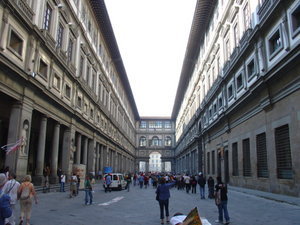Advertisement
Published: January 18th 2009

 The Uffizi Gallery Courtyard
The Uffizi Gallery Courtyard
Here's a real lesson in perspective. Surrounded by three wings of the musuem, this courtyard is typically buzzing with tourists, living statues, hawkers and excitement!Care to journey back with me to the 13th century to study the masters in one of the most famous art collections in the world? To get up close and personal with Giotto, Raphael, Michelangelo, Bernini and Caravaggio? To travel through time from Gothic, to Renaissance, to High Renaissance, to the Baroque with the Medici? Well, read on to see how we spent our first day in the Renaissance City of Florence!
We started out at the Uffizi Gallery at 8:30am, the time of our reservation. What do I mean by reservation? Well, after reading this posting you will understand fully. When we arrived at the Uffizi courtyard, the center of a giant "U" which is surrounded by the three wings of the museum, we found the entrance line stretching from Entrance #1 on one side of the street, winding down toward the Arno and then back up the other side of the street to Entrance #3 where you actually enter the museum to begin your tour. If you don't have a reservation in hand or are not part of a group, this line will eat up 2-3 hours of your day. This is exactly why we had ours. And

 Cosimo I
Cosimo I
The legacy of Medici and their influence on the city of the Renaissance began with Cosimo I, the Patriarch of the Medici Family. to help you avoid wasting precious moments of vacation time, I will explain how to get your reservations. But you'll have to wait to the end of this posting. Needless to say, we bypassed the line and arrived at Entrance #3 where we picked up our actual tickets and proceeded to the museum entrance. We were inside in less than five minutes. Ha!
Before we begin our journey through the museum, let me give a little history on the Uffizi Gallery. Established by the Medici in 1581, this world famous museum was originally commissioned by Cosimo I in 1560, the patriarch of the Medici family, and designed by Georgio Vasari, a very well known artist of the day and one of Cosimo's favorites. The edifice was intended to serve as offices or uffizis for the high-ranking magistrates of Florence. Over time, the Medici amassed a large collection of artwork; either purchased or commissioned, and stored them here in especially elaborate rooms such as the Tribuna, the red walled octagonal shaped room that houses some of the Medici's most prized collections. More on that later. When the Medici fell out of power, Anna Maria Luisa, the last Medici heiress, established

 Botticelli's The Birth of Venus
Botticelli's The Birth of Venus
You really have to see this in person to appreciate the vast size of canvas. the museum through a family pact that stated all of her possessions were never to leave Florence and then opened up the museum to the public in 1765. The rest, as they say, is history.
We began our journey a little winded after ascending 3 very long staircases to the top landing where you are greeted by the "family", the Medici Family that is. Busts of the prominent members surround you and it's at this point you begin your tour and understand just how influential this family was in Florence of the day.
After surrendering your ticket, you begin in the 13th century Gothic art rooms. Like the Vatican, the Uffizi too has quite a collection of this fascinating two-dimensional artistic style of painting that features prolific amounts of gold throughout the works. Lacking in the art of this time period was perspective, an idea born of a Renaissance man some 300 years later - Brunelleschi in the 15th century and demonstrated later by Masaccio in his Holy Trinity, a fresco on the inside wall of the Santa Maria Novella.
From here, the rooms travel through the centuries and we discovered Botticelli's "Primavera" and "Birth of Venus"

 Michelangelo's Doni Tondo
Michelangelo's Doni Tondo
This painting was one of the pioneering contributions that eventually lead to the a new era in art known as Mannerism. Fresh from the High Renaissance, Michelangelo painted this image of the Holy Family in the early 16th century. of which we purchased a print and had framed beautifully upon our return to the States. Stunningly beautiful, the "Birth of Venus" is rich in color and tells the story of Venus who arrives on this first day of creation, floating in a shell with the winds, Zephyr and Aura blowing her ashore. To her right, is one of the Three Graces, who is ready to offer her capes to cover her modest state. See for yourself.
As you continue your journey, you will come upon Michelangelo's "Doni Tondo", a painting of the Holy Family completed in the early 16th century and during the transitional phase from the "Renaissance" period to that of "Mannerism", around 1520. Giotto, Lippi, Carravagio, Raphael (Self Portrait), Leonardo (the unfinished Adoration of the Magi, Annunciation), Titian (Venus d'Urbino) Piero Della Francesca (Duke of Urbino), Parmigianino (The Madonna of the Long Neck) and countless others throughout. There are also rooms of Italian sculptures where you'll find Bernini's statue of The Martyred St. Lawrence, The Tribuna Room where the Medici kept their most treasured and valuable pieces of their collection. We continued through the ages and ended up in the 18th century.
As you weave

 Raphael - Self Portrait
Raphael - Self Portrait
Raphael must have really understood his appearance and every detail thereof for he looks the same in most paintings he appears. If you remember my posting from Rome and the Vatican Museum, Raphael looks just like this in the corner of the School of Athens fresco in the Raphael Rooms or Stanza di Raphaello.in and out of all of the connecting rooms, be sure to notice the ceilings in the outer hallways. What are known in the artistic world as "grotesques", not because of the subject matter but of the origin of the art form itself, are frescos painted in the 16th and 17th centuries. This style of painting derives its name from where they were first discovered, on the ceilings of grottos, hence "grotesques".
At last, we have almost completed our tour. There is one fascinating element of this museum that I want to share with you, a spectacular corridor, known as the Vasari Corridor, which was designed by the artist in 1565 as a wedding present to Francesco I and Joan of Austria. This "secret passageway" stretches from the Uffizi Gallery, down along the Arno River, across the river via the Ponte Vecchio, and finally adjoins the Pitti Palace and Boboli Gardens ("The" Medici Palace of Florence and the topic of a later posting). It was reserved exclusively for the Medici who traveled this kilometer long passageway by pulling themselves by hand along its entire length. Dismaying as it may be, this clandestine corridor is not open to general public.

 Uffizi Museum -
Uffizi Museum -
Hallway outside the interconnecting rooms that feature "grotesques" on the ceiling......these frescos are quite the antipathy of how that word translates today!However, if your one of the lucky ones who may traverse its path as part of a special group or school tour, you'll be in for a real treat. If any of you have made this journey, I am jealous so please send me a comment so I can live vicariously through you! Check it out.
Now that we are at the end of our first tour in Florence, allow me to impart a few essential tips. Before we left for Europe, I investigated a lot of the places we planned to visit online and in the books I recommend on this site. I also checked many tour websites that featured group and private tours of the city, the churches, the museums and other popular sights. Only a few hours in length, these tours are a great introduction if you're a first time visitor.
We booked our tour, almost a full day, through
Avventure Bellissime. One of their most popular tours features a guided city walk in the morning to learn about the architecture, the historical sights, the Medici and the role that Florence played in one of the most influential and reawakening periods in history, the Renaissance!

 Vasari Corridor
Vasari Corridor
If you look at the square windows above the Ponte Vecchio shops, this is where the Vasari Corridor resides. The almost kilometer long hidden passageway stretches from the Uffize, to the right, down to the Ponte Vecchio, across the bridge and terminates at the Pitti Palace in Otrarno. Following our morning walk, was the guided tour of the Accademia to see Michelangelo's David. Later in the afternoon, we all met up at the Uffizi Gallery. I strongly recommend this tour and it's well worth the price because not only do you get a great introduction to the city and learn the significance of the architecture, the popular sights, etc, you don't have to worry about the price of museums nor the strongly recommended advanced reservations. If a whole day doesn't appeal to you, then book a shorter tour of one museum. The site offers a variety. Take a look.
Now, if you want to skip the tour, it's understandable since the cost may be more than you want to spend, however make your reservations for the museums at the very least. There's a small fee but it's well worth it. I think I have made my point here. And be sure to rent an audio guide. We did that on our last trip there. I do have one last secret to share but be sure you don't tell anyone! Ask your hotel to make the reservations for you. Since you are a paying customer, you will find

 Titian's Venus d'Urbino
Titian's Venus d'Urbino
Another classic by another master painted in 1538.they are most amenable. Our friend, Miriam at the Monna Lisa, was only too happy to oblige when we asked her to book the Uffizi and Academia. Oh and leave your cameras in your rooms because no pictures allowed.
It's time to head to the Accademia to see Michelangelo, The Florentine's, "David" - my next posting.
Arrivederci!!!!! Be sure to visit
The EuroTraveler for more stories of my experiences and the resources you need to help you plan your holiday!
Advertisement
Tot: 0.057s; Tpl: 0.015s; cc: 10; qc: 18; dbt: 0.0182s; 1; m:domysql w:travelblog (10.17.0.13); sld: 1;
; mem: 1.1mb















liliram
liliram
Thanks, Jeff.........
This is truly very educational. I'm sure to read this more than a couple of times, to refresh my memory. Thanks for the tips too. And hey, i so love that picture of Matthew with cupid! Keep writing, Jeff!